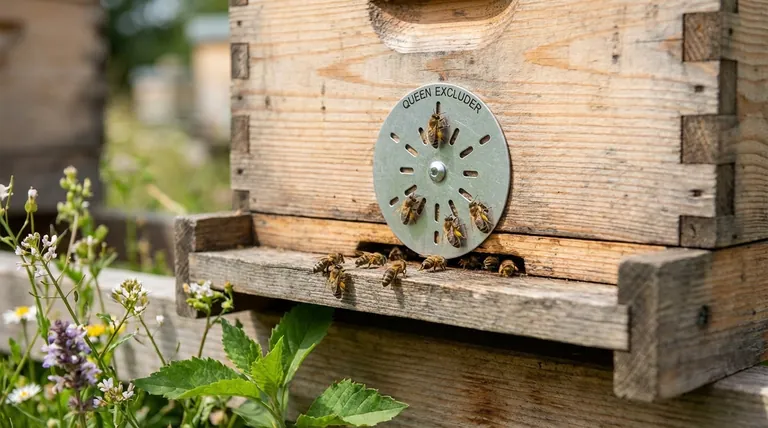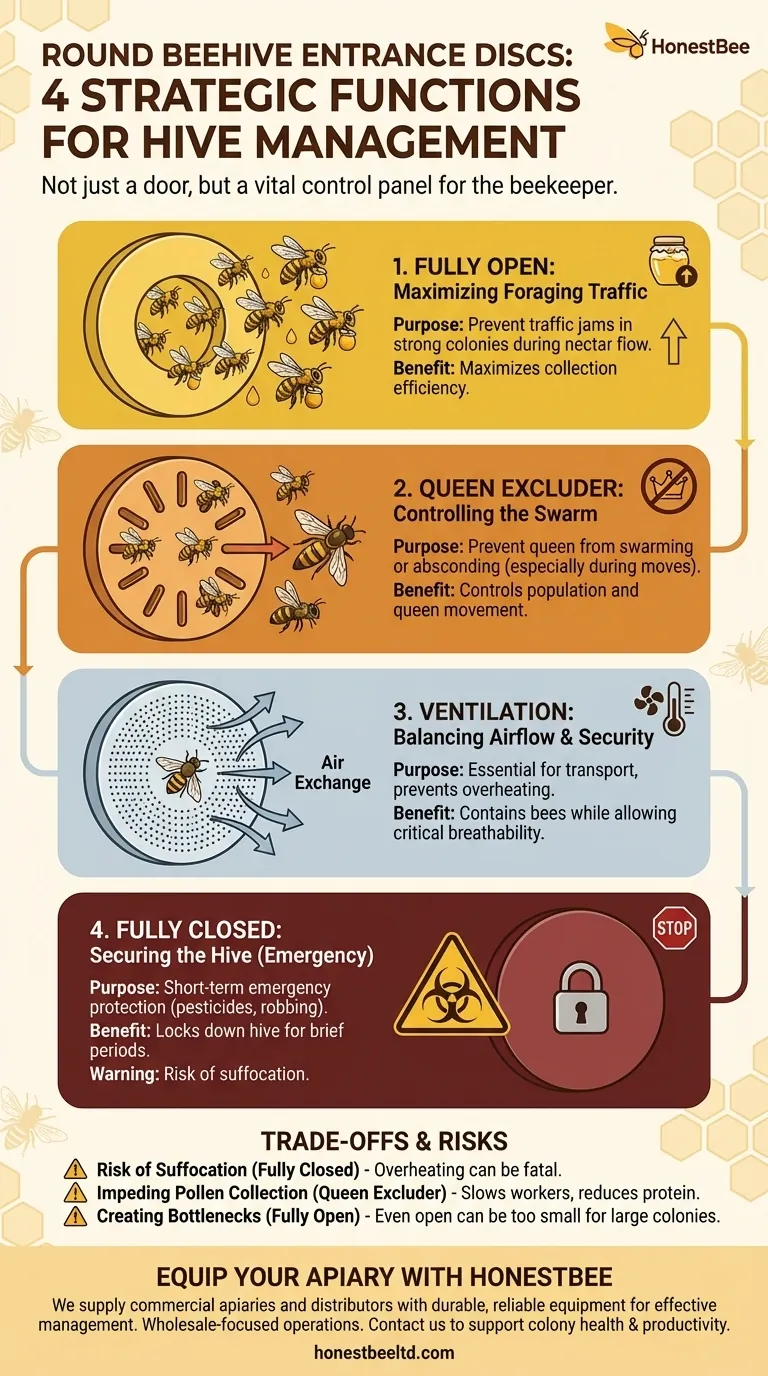At first glance, a round beehive entrance disc is a simple piece of plastic or metal. However, this small device serves four distinct and critical functions for hive management: it can be set to fully open, queen exclusion, ventilation only, or fully closed. Each setting is a strategic choice that directly impacts the colony's security, workflow, and survival.
This disc is not just a door; it is a vital control panel for the beekeeper. Understanding when and why to use each of its four settings is fundamental to managing colony health, defending against threats, and controlling population dynamics throughout the year.

The Four Settings: A Strategic Breakdown
Each position on the entrance disc solves a specific problem a beekeeper might face. Using the right setting at the right time can prevent disaster and promote a thriving colony.
The 'Fully Open' Position: Maximizing Foraging Traffic
This is the largest opening on the disc and should be considered the default setting for a strong, healthy colony during a nectar flow.
Its primary purpose is to prevent a "traffic jam" of forager bees entering and exiting the hive. A wide-open entrance maximizes the efficiency of the colony's collection efforts.
The 'Queen Excluder' Position: Controlling the Swarm
This setting features several smaller slots. These slots are large enough for worker bees to pass through but are too small for the larger queen and drones.
Its most common use is to prevent a queen from leaving with a swarm. It is also used when moving a hive to ensure the queen does not abandon the colony (abscond) due to the disturbance.
The 'Ventilation' Position: Balancing Airflow and Security
This position is perforated with tiny holes that are too small for any bee to pass through, but large enough to allow for critical air exchange.
This setting is essential when transporting a colony. It keeps the bees contained while preventing them from overheating and suffocating, which can happen very quickly. It is also a temporary defensive measure if you need to block access without cutting off all air.
The 'Fully Closed' Position: Securing the Hive
This is a solid, completely sealed position that allows nothing in or out. It is an emergency setting to be used with extreme caution.
Its main purpose is to lock down the hive for very short periods, such as during transport or when protecting the colony from nearby pesticide spraying. It can also be used to stop a severe robbing attack from other bees, but only for the briefest possible time.
Understanding the Trade-offs and Risks
While useful, improper use of the entrance disc can harm your bees. A beekeeper must be aware of the potential downsides of each setting.
Risk of Suffocation and Overheating
Using the 'Fully Closed' setting for more than a very short time can be fatal. A colony generates significant heat and requires constant airflow. Even the 'Ventilation' setting may be insufficient on a hot day or during a long-distance move.
Impeding Pollen Collection
The 'Queen Excluder' entrance can significantly slow down worker bees. More importantly, it can scrape off the pollen pellets that foragers carry on their legs, reducing the colony's protein income and hampering its growth.
Creating an Unnecessary Bottleneck
For a very large, booming colony, even the 'Fully Open' setting on a small disc can create a bottleneck that reduces foraging efficiency. In these cases, some beekeepers remove the disc entirely to provide an unrestricted entrance.
Making the Right Choice for Your Goal
Your decision should always be based on the colony's current needs and the environmental conditions.
- If your primary focus is nectar collection in a strong hive: Use the 'Fully Open' setting to maximize foraging efficiency.
- If your primary focus is preventing a swarm or queen loss during a move: Use the 'Queen Excluder' setting, but only for the necessary period.
- If your primary focus is transporting bees safely: Use the 'Ventilation' setting to ensure the bees are contained but can still breathe.
- If your primary focus is short-term emergency protection: Use the 'Fully Closed' setting, but monitor the hive closely and reverse the setting as soon as the threat has passed.
By mastering this simple tool, you gain significant control over the health, safety, and productivity of your colony.
Summary Table:
| Setting | Purpose | Key Benefit |
|---|---|---|
| Fully Open | Maximize foraging traffic | Prevents traffic jams for strong colonies |
| Queen Excluder | Prevent swarming/absconding | Controls queen movement during hive moves |
| Ventilation | Allow airflow during transport | Prevents overheating while containing bees |
| Fully Closed | Short-term emergency protection | Secures hive from threats like pesticides or robbing |
Ready to equip your apiary with professional-grade entrance discs and other essential beekeeping supplies?
At HONESTBEE, we supply commercial apiaries and beekeeping equipment distributors with the durable, reliable tools needed for effective hive management. Our wholesale-focused operations ensure you get the quality equipment your business depends on.
Contact our team today to discuss your needs and discover how HONESTBEE can support the health and productivity of your colonies.
Visual Guide

Related Products
- HONESTBEE Professional Multi-Functional Hive Tool with Ergonomic Wood Handle
- Multi-Function Plier-Style Frame Grip Hive Tool
- HONESTBEE Professional Long Handled Hive Tool with Precision Cutting Blade
- Professional Dual-End Stainless Steel Hive Tool for Beekeeping
- Professional Multi-Function Stainless Steel Hive Tool
People Also Ask
- What types of hive tools are available for beekeepers? Choose the Right Lever for Your Apiary
- Why is it recommended to have multiple hive tools on hand? Essential Tips for Efficient Beekeeping
- Why do hive tools have a hole? Unlock the Secret to Efficient Beekeeping
- What is a J-hook hive tool and why is it favored by some beekeepers? Master Gentle Frame Handling
- What is the hole in a hive tool for? A Multi-Tool for Apiary Repairs and Maintenance



















